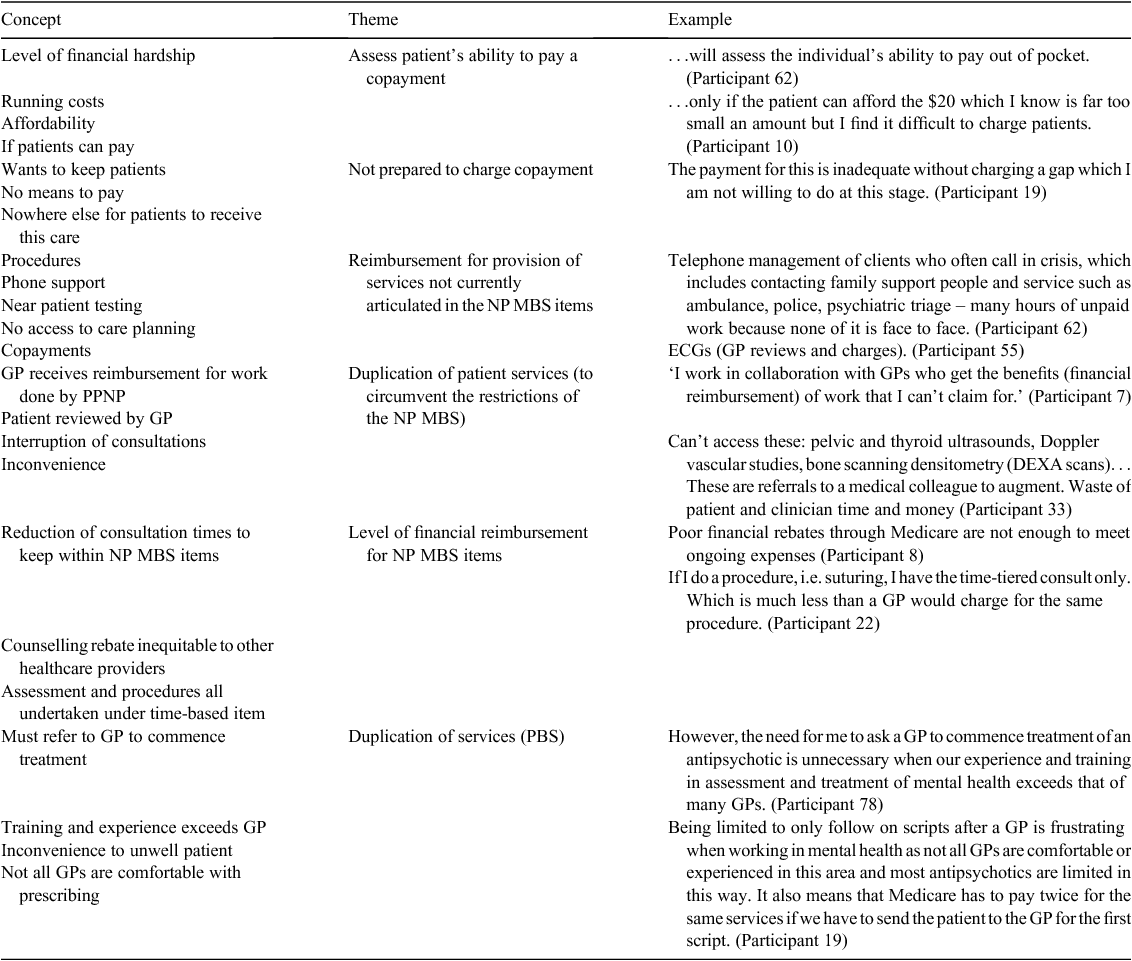Privately practising nurse practitioners’ provision of care subsidised through the Medicare Benefits Schedule and the Pharmaceutical Benefits Scheme in Australia: results from a national survey
Jane Currie A B , Mary Chiarella A and Thomas Buckley AA Sydney Nursing School, University of Sydney, 88 Mallett Street, Camperdown, NSW 2050, Australia. Email: mary.chiarella@sydney.edu.au; tom.buckley@sydney.edu.au
B Corresponding author. Email: jane.currie@sydney.edu.au
Australian Health Review 43(1) 55-61 https://doi.org/10.1071/AH17130
Submitted: 17 December 2016 Accepted: 8 September 2017 Published: 16 October 2017
Journal Compilation © AHHA 2019 Open Access CC BY-NC-ND
Abstract
Objective Since legislative changes in 2010, certain health care services provided by privately practising nurse practitioners (PPNPs) in Australia have been eligible for reimbursement under the Medicare Benefits Schedule (MBS) and the Pharmaceutical Benefits Scheme (PBS). The aim of the present study was to describe survey results relating to the care provided by PPNPs subsidised through the MBS and PBS.
Methods PPNPs in Australia were invited to complete an electronic survey exploring their practice activities. Quantitative data were analysed using descriptive statistics and 95% confidence intervals were calculated for percentages where relevant. Free text data were analysed using thematic analysis.
Results Seventy-three PPNPs completed the survey. The most common form of payment reported (34%; n = 25) was payment by direct fee for service (MBS rebate only, also known as bulk billing). Seventy-five per cent of participants (n = 55) identified that there were aspects of care delivery not adequately described and compensated by the current nurse practitioner (NP) MBS item numbers. 87.7% (n = 64) reported having a PBS prescriber authorisation number. Themes identified within the free text data that related to the constraints of the MBS and PBS included ‘duplication of services’ and ‘level of reimbursement’.
Conclusion The findings of the present study suggest that PPNPs are providing subsidised care through the MBS and PBS. The PPNPs in the present study reported challenges with the current structure and breadth of the NP MBS and PBS items, which restrict them from providing complete episodes of patient care.
What is known about the topic? Since the introduction of legislative changes in 2010, services provided by PPNPs in Australia have been eligible for subsidisation through the MBS and PBS.
What does this paper add? This paper provides data on PPNPs’ provision of care subsidised through the MBS and PBS.
What are the implications for practitioners? Eligibility to provide care subsidised through the MBS and PBS has enabled the establishment of PPNP services. The current breadth and structure of the NP MBS and PBS item numbers have restricted the capacity of PPNPs to provide complete episodes of patient care.
Additional keywords: collaborative arrangement, nurse-led clinics, primary health care.
Introduction
The intent of introducing nurse practitioners (NPs) into the Australian health workforce, and subsequently as eligible providers under the Medicare Benefits Schedule (MBS) and the Pharmaceutical Benefits Scheme (PBS), was to improve access to health services by increasing the flexibility and scope of the health workforce.1 To enable NPs to provide full episodes of patient care, they are endorsed to prescribe medications, initiate and interpret diagnostic imaging and pathology investigations and make referrals to other healthcare providers. As of March 2017, there were 1519 NPs endorsed to practise in Australia,2 although to date there are no data detailing their distribution between the private and public sectors.
Prior to their eligibility for the MBS and PBS, NPs in Australia worked predominantly in the public acute sector rather than in community and primary care settings. In the initial discussion paper on implementing NPs in Australia, the potential examples of the role focused on increasing access to care to underserved populations, including the homeless, those in rural and remote areas and those with mental health issues.1 Lack of NP access to the MBS and PBS was identified as an impediment to their proliferation in community and primary care roles.3
For the purpose of the present study, NPs working in private practice have been termed ‘privately practising nurse practitioners’ (PPNPs). The PPNP model has been defined as ‘one by which reimbursement for health care provided by [an] NP is based on fees for service received from an individual, health insurance scheme or other third party’.4
Since their admission to the MBS and PBS (Health Legislative Amendment (Midwives and Nurse Practitioners) Act 2010 (Cth)) several PPNP services have been established in Australia. Examples, predominantly in the primary healthcare setting, include NPs integrating with community-based pharmacy providers,5 community mental health6 and general practice settings.7
Existing literature highlights several issues impacting on the sustainability of PPNPs, including limited access to the necessary range of MBS items,7–9 the level of reimbursement allocated to NP MBS items compared with those available to medical practitioners for what amounts to the same service4,7 and the complexity of mandated collaborative arrangements.10
Currently there are four NP MBS consultation item numbers, each time based and ranged up to consultations lasting at least 40 min.11 There are six telehealth item numbers also characterised by length of time, location of the patient and the presence of a medical specialist.11 The PPNPs also have access to a limited number of investigative items (a full description of the item numbers is available at http://www.health.gov.au/internet/main/publishing.nsf/content/midwives-nurse-pract-qanda-nursepract, accessed 7 September 2017). To obtain an MBS provider number and a PBS prescriber number, PPNPs must first establish a collaborative arrangement with either a specified medical practitioner or an entity that employs medical practitioners (National Health (Collaborative arrangements for nurse practitioners) Determination (Cth) 2010).12 This mandated collaborative arrangement provides for consultation, referral and transfer of care, as clinically relevant.
To date, there are two published evaluations of Australian PPNP services available. One is focused on services provided in a Women’s Health Clinic in Tasmania and reports on the constraints of current NP MBS access and the subsequent duplication of care this creates between medical practitioners and PPNPs.9 The second was funded by the Department of Health and Ageing and evaluated NP services in aged care between 2012 and 2013, many of which were PPNP services.8 An important finding of this latter study was that PPNPs had a positive effect on patient access to primary health care, particularly identifying deteriorating patients and intervening to avoid hospital admissions. However, models of PPNP care delivery that relied solely on the scheduled fee allocated to NP MBS items were not financially viable,8 and therefore unlikely to demonstrate long-term sustainability.
There has been very little workforce surveillance of PPNPs in Australia. So far, there have been no published national data on PPNPs’ access to the MBS and PBS. Such data would assist in understanding PPNPs’ patterns of access to the MBS and PBS and may highlight any existing or potential constraints PPNPs experience in providing subsidised care to patients and their capacity to provide care to underserved populations.
The present study is part of an evaluation of PPNP services in Australia, comprising a national survey and interviews with PPNPs.13 The overall aim of the present study was to evaluate how, why and in which contexts PPNP activity impacts on patient access to care. The data presented herein are based on several questions extracted from the national survey that focus on PPNPs’ utilisation of the MBS and PBS in Australia. The purpose of the present study was to understand how and why PPNP MBS reimbursement processes impact on patient access to care. Survey results relating to workforce characteristics,14 collaborative arrangements10 and practice activities15 have been published previously. Results related to the interviews with PPNPs have not yet been published.
Methods
Design
An electronic survey was designed to evaluate the impact of PPNP services in Australia on access to health care. The 82 survey questions were informed by current literature4 and focused on the following aspects of PPNP practice: workforce characteristics, clinical governance, collaborative arrangements, scope of practice, access to the MBS and PBS, practice activities and practice setting. Most survey questions were quantitative ‘yes’ or ‘no’ questions, with free text space for participants to explain their response. There were four open-ended questions, none of which related to the MBS or PBS. Survey design used skip logic, which meant that the questions available to participants were dependent on their answers to each question. Within the survey, participants responded to 12 questions related to the MBS and PBS (Table 1) and only these data are presented here. A pilot (n = 6) of the survey was undertaken and minor amendments made as appropriate.
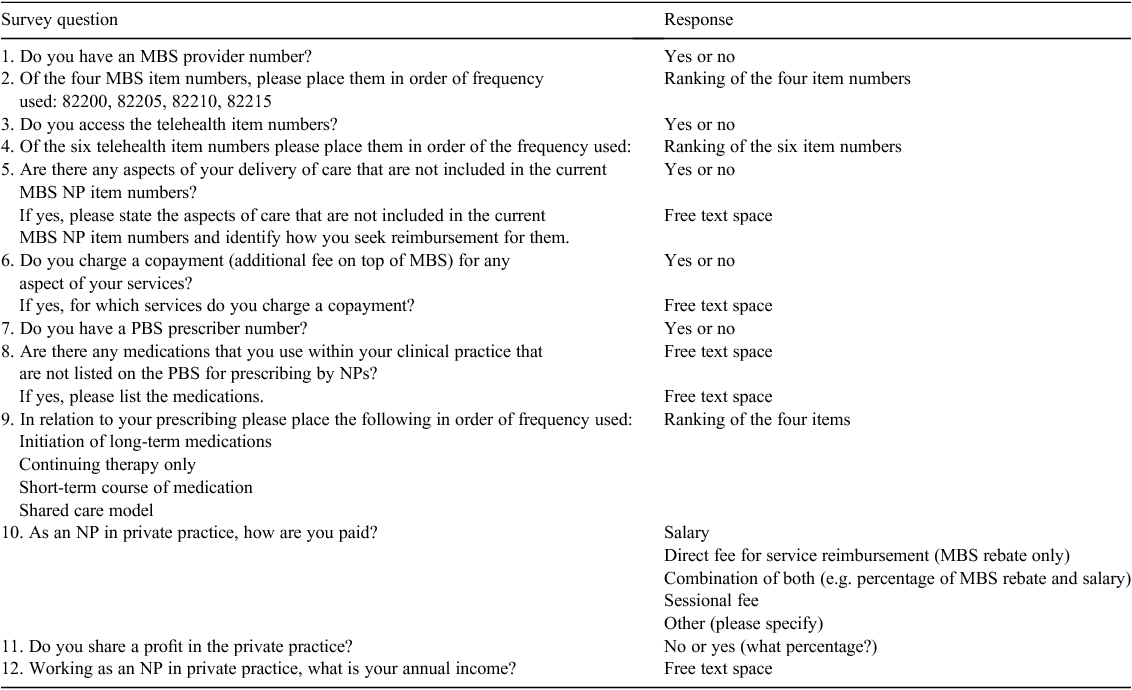
|
Realist evaluation provides the overarching theoretical framework of the present evaluation.13 Realist evaluation is a theory-driven approach, in which researchers start with a theory to be tested, often through a pluralist mixed-method research design, and end with a more refined theory. In this case, initial theory was synthesised through discussions with stakeholders and advisers and a review of the literature. A national survey was then designed to test these theories and explore the practice activities of PPNPs, because little was known previously. Survey results that relate to PPNPs’ access to the MBS and PBS are herewith presented descriptively.
Study participants
Eligible participants included PPNPs in Australia, or NPs who had previously been engaged in private practice. To recruit participants, the authors requested key organisations to disseminate an email invitation to endorsed NPs, or to advertise a flyer on their website. The organisations approached included the Australian College of Nurse Practitioners, the Australian College of Nursing and the Australian Practice Nurse Association. In addition, the Chief Nursing and Midwifery Officers of each state and territory were asked to assist. Participants then accessed the survey via a web link sent to them in an email; the first question of the survey requested participant consent.
Data collection and analysis
Data were collected using an electronic questionnaire on the SurveyMonkey platform over 6 weeks between February and March 2015. In total, 76 PPNPs responded and commenced the survey, with 73 providing valid data for analysis; three participants answered no questions other than demographics. Quantitative data were imported into SPSS version 22.0 (IBM Corp., Armonk, NY, USA) for analysis using descriptive statistics. To provide plausible ranges of values, 95% confidence intervals (CIs) have been calculated for percentages where relevant. The free text answers were analysed using an adaptation of Braun and Clarke’s16 thematic analysis. The data were read and reread (familiarisation) and key concepts were identified (coding). All recurring concepts were grouped together and named (searching for themes). The process of extracting the key concepts was reviewed by all authors and unanimous agreement reached on their interpretation (reviewing themes).16
Ethics approval
The University of Sydney Ethics Committee approved the study (2014/696). All participants were provided with written information about the study and all provided informed consent before partaking in the study.
Results
PPNP characteristics of access to the MBS
Participant characteristics are shown in Table 2. Eighty-nine per cent of participants (n = 65) reported being issued an MBS provider number. Participants were asked to place the four NP MBS item numbers in order of the frequency used (Table 3). Nine participants (12.3%) reported using the NP telehealth item numbers. Neither item 82223 (consultation <20 min duration, residential care) nor item 82222 (consultation at least 40 min duration, outside inner metropolitan area, 15 km by road) were identified as the most frequently used.
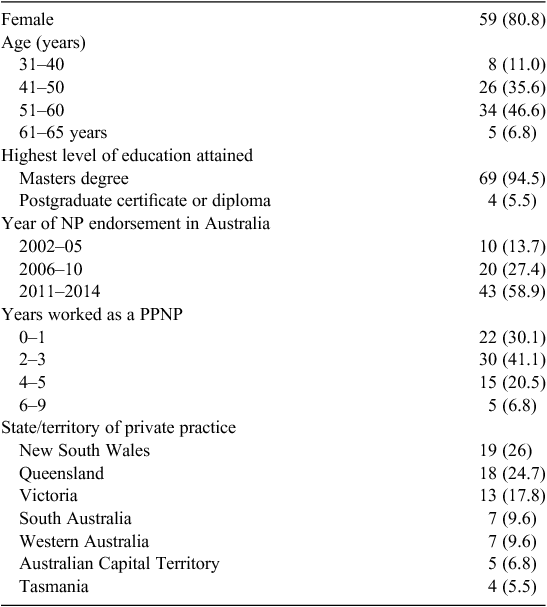
|
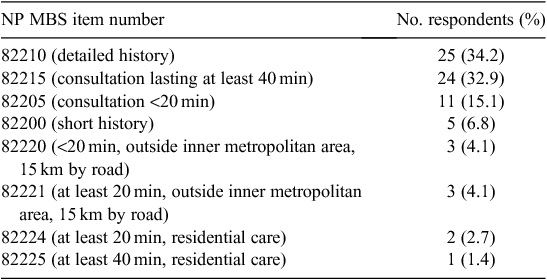
|
Because of the variety of work settings and work arrangements of the participants, there is broad variation in how participants reported being paid. Twenty-five participants (34%; 95% CI 24–46%) reported being paid by direct fee for service (MBS rebate only), 16 participants (21.9%; 95% CI 14–33%) received a salary, 10 (13.7%; 95% CI 8–23%) received a combination of salary and direct fee for service and seven (9.6%; 95% CI 5–18%) received a sessional fee (agreed fee for provision of a specific service, such as clinic session). Three participants (4%; 95% CI 1–11%) received 100% payment (no MBS rebate) from patients. One participant (1.4%; 95% CI 0–7%) received a combination of the MBS scheduled fee, a copayment (a payment made by the patient in addition to the MBS scheduled fee allocated to the NP subsidised item; also known as a ‘gap’ or ‘out-of-pocket fee’) and other government funding (e.g. better access to mental health care, victims of crime funding for trauma counselling). One participant (1.4%; 95% CI 0–7%) reported receiving payment of a sessional fee and MBS rebate and another participant (1.4%; 95% CI 0–7%) reported receiving an MBS rebate and a copayment. Eleven participants (15%; 95% CI 9–25%) shared a profit in the private practice; the percentage of profit received ranged from 25% to 100%, with a median of 40%.
Of those participants who reported their annual income (54.7%; n = 40), the median income of those participants who worked part-time (including casual and sessional) was A$44 000 (range A$500–110 000). The median income of participants who worked full-time was A$96 650 (range A$50 000–$350 000).
Although only a small percentage of participants reported being paid directly through copayments (additional fee on top of an MBS rebate), a far larger percentage reported charging a copayment. Thirty-three participants (45%; 95% CI 34–57%) charged a copayment for their services. The services for which participants charged a copayment are listed in Table 4; note that three PPNPs charged a copayment for more than one aspect of care.
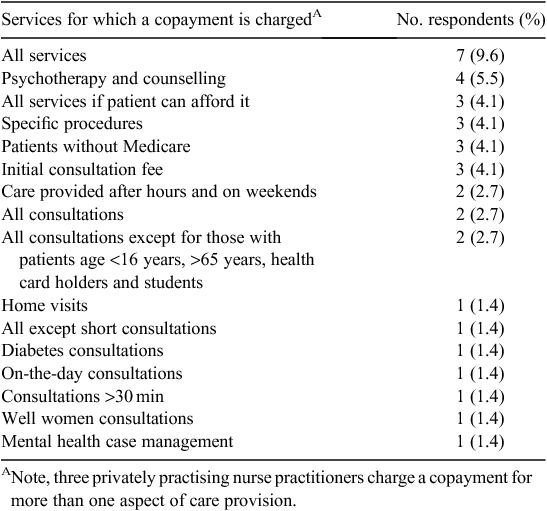
|
Themes in the free text responses related to copayments indicated that, before charging a copayment, PPNPs tended to evaluate a patient’s ability to pay. If patients were unable to afford the fee, then the PPNP may not charge a copayment. Not all participants were prepared to charge a copayment (Table 5).
Constraints of the existing NP MBS item numbers
Seventy-five per cent of participants (n = 55) identified that there were aspects of care delivery that were neither adequately described nor adequately compensated by the current NP MBS item numbers. Nineteen participants provided free text examples of aspects of care not available to NPs via the current MBS (Table 6). The concepts and themes identified within the free text responses included reimbursement for provision of services not currently articulated in the NP MBS items and duplication of patient services and the level of reimbursement (Table 5).
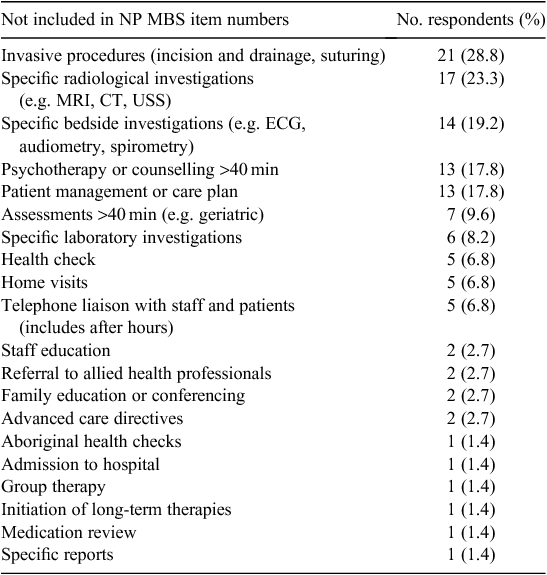
|
PPNP access to the PBS
Eighty-seven per cent of participants (n = 64) reported having a PBS prescriber authorisation number. Most (94.5%; n = 69) reported prescribing medications as part of their role and 34.2% (n = 25) reported that there were medications that they used within their clinical practice that were not listed on the PBS for prescribing by PPNPs; one example were all medications listed in the Repatriation Pharmacuetical Benefits Schedule, which PPNPs are currently not eligible to prescribe.
Participants were asked to rank the frequency of the type of prescribing they undertake, with 39.7% (n = 29) most regularly prescribing short-term courses of medication such as antibiotics and analgesics. Twenty per cent of participants (n = 15) ranked continuing therapy only (CTO) medications (i.e. the medication must be initiated by a medical practitioner and can then be continued by a PPNP17) as their most common prescription and 12.3% (n = 9) ranked initiation of new long-term medications as most common. Eleven per cent of participants (n = 8) reported a shared care model (SCM; i.e. a formalised shared care arrangement between a PPNP and a medical practitioner17) as their most common prescription. The main theme in the free text responses was the reported duplication of services required for medications listed in the PBS as CTO (Table 5).
Discussion
This paper reports some of the results of a national survey of PPNPs, with a specific focus on describing the utilisation of the MBS and PBS by PPNPs. The legislative changes enabling PPNPs to provide subsidised services through the MBS and PBS have facilitated a growth in PPNP services. Many of these PPNP services have been designed to meet gaps in service in chronic and complex, as well as primary health care.14 Analysis of the NP MBS item numbers between 2010 and 2016 via the Department of Human Services identified an upward trend for MBS access by NPs, although the volume is currently small compared with that of general practitioners (GPs).18
Capacity of PPNPs to provide complete episodes of care
Although eligibility for the MBS and PBS appears to have enabled the development of PPNP services, the findings of the present study suggest that the current structure of the MBS and PBS does not enable all PPNPs to provide complete episodes of care. The restrictions of the NP MBS and PBS items have the potential to reduce the capacity of PPNPs to function to the full scope of their practice when providing subsidised care. In the national survey data relating to PPNPs’ practice activities, only 59% of PPNPs (n = 43) perceived that they worked to the full scope of their practice as a PPNP.15 The issues affecting the capacity of PPNPs to complete an episode of patient care identified in the present study are the time-based structure of the MBS, limited access to investigative and procedural MBS items, the inability to refer to allied health professionals through the MBS and medications listed as CTO and SCM on the PBS and those listed in the Repatriation Pharmacuetical Benefits Schedule.
To enable patients to obtain necessary referrals for diagnostic investigations that are not available to PPNPs to initiate under the MBS (e.g. a female pelvic ultrasound), participants reported frequently referring patients to a GP, thereby duplicating and fragmenting patient care. This outcome creates several issues: (1) it inconveniences the patient, with the potential of decreasing compliance with necessary care; (2) it increases the cost of health care because the patient claims for two attendances to a healthcare provider rather than only one; and (3) it means that the results of any investigations will be sent back to the GP and not to the treating PPNP, who may well be the patient’s primary care provider. Given that the original intent of the introduction of the NP role was to reduce fragmentation and duplication of services by enabling highly qualified nurses to work to the full scope of practice and free up medical practitioners for other work,1 the restrictions imposed by these limited NP MBS items seem to be counterproductive.
PPNPs also reported the challenges of contacting a patient’s GP to prescribe SCM and CTO medications. They made the salient point that in circumstances where the PPNP has specialist expertise in a field that a GP does not (e.g. mental health), this process seemed superfluous and unnecessary.
Financial viability of PPNP services
The findings of the present study also suggest the challenge of maintaining a viable business model using only the MBS rebate. The NP scheduled benefit is significantly lower than that of other health practitioners. For example, the present study identified that the most frequently used NP MBS item number is 82210 (detailed history). The fee for item 82210 is A$39.75, of which A$33.80 is allocated as the scheduled benefit.19 Comparative medical practitioner item number 36 (professional attendance by a GP at consulting room, lasting at least 20 min) has a fee of A$71.70, of which A$71.70 is allocated as the scheduled benefit.19 Comparative occupational therapy item number 10958, (assessment lasting at least 20 min duration) has a fee of A$62.25, of which A$52.95 is the scheduled benefit.19 Similarly, the second most frequently used NP MBS item number, 82215 (consultation lasting at least 40 min), commonly used by PPNPs providing psychotherapy, carries a fee of A$58.55, with reimbursement of A$49.80.19 Comparative clinical psychologist item number 80000 for providing a psychological assessment between 30 and 50 min duration carries a fee of A$99.75 and the scheduled benefit is A$84.80.19
A recent evaluation of Australian NP aged care models of practice undertaken by the Federal Government identified that, to be financially viable, the models needed to access sources of funding other than the MBS revenue,8 which is frequently prohibitive for populations cared for by PPNPs. In fact, 30% of the models of care included in this Federal Government evaluation ceased to operate because they were not financially sustainable, and it was concluded that MBS income alone was not adequate to fund the models.8
The implications of the restrictive design of the MBS and PBS highlighted in the present study are not unique to PPNPs. Some of the MBS item numbers accessed by other health professionals are also time based and thereby have the potential to incur similar constraints on practice. Certain allied health professionals also have limited access to investigative items through the MBS, thereby limiting the scope of practice they can provide. Although this is a shared concern and one that stems from the broader design of the MBS, the focus of the present study is PPNPs, and the concern for PPNPs themselves (and for patients treated by PPNPs) is that the restrictive nature of the MBS items is counterproductive in achieving the intent of PPNPs’ eligibility to provide subsidised care; that is, to reach underserved populations.
Effect of PPNP access to the MBS and PBS on patient access to care
Findings from the present study suggest that the current structure of the NP MBS and PBS items will require some further development in order for PPNP services to be consistently able to provide complete episodes of patient care. Specifically, the time-based structure of the MBS item numbers and the level of reimbursement have the potential to threaten the financial viability of PPNP services. In some instances, PPNPs charge a copayment, and this could affect patient compliance with treatment or dissuade patients from seeking care in the first instance. It may also have a subsequent effect on other areas of the health system, such as emergency departments, where patients may choose to seek care that does not attract a fee. The limited MBS referral items mean that PPNPs often need to refer patients to their GP to provide complete episodes of care, thereby increasing the burden on GPs and inconveniencing patients.
Study limitations
The present study has limitations. It is unknown how many PPNPs are currently working in Australia, therefore the generalisability of the study sample is unknown. Future research is required to confirm the actual number of PPNPs in the Australian context. Participants were asked to report their annual income. It is unclear whether participants have reported their gross or net income because this was not specified in the survey question. In reporting which medications were not available for prescription by PPNPs via the PBS, several participants reported classes or groups of medications rather than specific drug names. These groups of medications were too broad to include in the analysis. It is noted that medications are regularly updated in the PBS and therefore PPNPs’ eligibility to prescribe specific medications may have changed since participants completed the survey in 2015.
Conclusion
The findings of the present study suggest that PPNPs are providing subsidised care through the MBS and PBS and that they are servicing underserved populations. The PPNPs in the present study reported challenges with the current structure of the NP MBS and PBS item numbers, which restrict them from providing complete episodes of patient care. Further research and policy are required to ensure that the structure of the NP MBS and PBS items enable PPNPs to maximise their impact on access to care by the populations they serve.
Competing interests
The authors declare no competing interests.
Acknowledgements
The authors thank the Australian College of Nursing, Australian College of Nurse Practitioners, Australian Practice Nurse Association and the Offices of the Chief Nurse and Midwife for their assistance in the dissemination and advertisement of the survey.
References
[1] New South Wales Health. Nurse practitioners in New South Wales: discussion paper. Sydney: NSW Health; 1992.[2] Nursing and Midwifery Board Australia. Quarterly registration data March 2017. 2017. Available at: http://www.nursingmidwiferyboard.gov.au/About/Statistics.aspx [verified 1 July 2017].
[3] Harvey C. Legislative hegemony and nurse practitioner practice in rural and remote Australia. Health Sociol Rev 2011; 20 269–80.
| Legislative hegemony and nurse practitioner practice in rural and remote Australia.Crossref | GoogleScholarGoogle Scholar |
[4] Currie J, Chiarella M, Buckley T. An investigation of the international literature on nurse practitioner private practice models. Int Nurs Rev 2013; 60 435–47.
| An investigation of the international literature on nurse practitioner private practice models.Crossref | GoogleScholarGoogle Scholar | 1:STN:280:DC%2BC2c%2FltFGjsg%3D%3D&md5=3c7cd5dff73fd9abf9eb1cd74c7a9384CAS |
[5] McMillan SS, Emmerton L. Practitioners: an insight into their integration into Australian community pharmacies. Res Social Adm Pharm 2013; 9 975–80.
| Practitioners: an insight into their integration into Australian community pharmacies.Crossref | GoogleScholarGoogle Scholar |
[6] Raeburn T, Hungerford C, Sayers J, Escott P, Lopez V. Leading a recovery-oriented social enterprise. Issues Ment Health Nurs 2015; 36 362–9.
| Leading a recovery-oriented social enterprise.Crossref | GoogleScholarGoogle Scholar |
[7] Helms C, Crookes J, Bailey D. Financial viability, benefits and challenges of employing a nurse practitioner in general practice. Aust Health Rev 2015; 39 205–10.
| Financial viability, benefits and challenges of employing a nurse practitioner in general practice.Crossref | GoogleScholarGoogle Scholar |
[8] Davey R, Clark S, Goss J, Parker R, Hungerford C, Gibson D. National evaluation of the nurse practitioner – aged care models of practice initiative, 2011–2014. Summary of findings. Canberra: Centre for Research & Action in Public Health, UC Health Research Institute, University of Canberra; 2015. Available at: https://www.canberra.edu.au/research/institutes/health-research-institute/annual-reports/reports/NPACM-Summary-of-Findings-Dist-Low-res.pdf [verified 11 September 2017].
[9] Elmer S, Stirling C. Evaluation of the nurse practitioner role at the Hobart Women’s Health Centre. Hobart, Tas.: University of Tasmania; 2013.
[10] Currie J, Chiarella M, Buckley T. Collaborative arrangements and privately practising nurse practitoners in Australia. Results of a national survey. Aust Health Rev 2016;
| Collaborative arrangements and privately practising nurse practitoners in Australia. Results of a national survey.Crossref | GoogleScholarGoogle Scholar |
[11] Department of Health. Eligible nurse practitioners questions and answers. 2014. Available at: http://www.health.gov.au/internet/main/publishing.nsf/content/midwives-nurse-pract-qanda-nursepract [verified 12 November 2016].
[12] Department of Health. Collaborative arrangements for participating midwives and nurse practitioners. 2012. Available at: http://www.health.gov.au/internet/main/publishing.nsf/Content/midwives-nurse-pract-collaborative-arrangements [verified 1 November 2016].
[13] Currie J, Chiarella M, Buckley T. Preparing a realist evaluation to investigate the impact of privately practising nurse practitioner services on patient access to care in Australia. Intl Jnl Nurs 2016; 2 1–10.
| Preparing a realist evaluation to investigate the impact of privately practising nurse practitioner services on patient access to care in Australia.Crossref | GoogleScholarGoogle Scholar |
[14] Currie J, Chiarella M, Buckley T. Workforce characteristics of privately practicing nurse practitioners in Australia. Results of a national survey. J Am Assoc Nurse Pract 2016; 28 546–53.
| Workforce characteristics of privately practicing nurse practitioners in Australia. Results of a national survey.Crossref | GoogleScholarGoogle Scholar |
[15] Currie J, Chiarella M, Buckley T. Practice activities of privately practicing nurse practitioners in Australia. Results of a national survey. Nurs Health Sci 2017;
| Practice activities of privately practicing nurse practitioners in Australia. Results of a national survey.Crossref | GoogleScholarGoogle Scholar |
[16] Braun V, Clarke V. Using thematic analysis in psychology. Qual Res Psychol 2006; 3 77–101.
| Using thematic analysis in psychology.Crossref | GoogleScholarGoogle Scholar |
[17] Department of Health. Browse by nurse practitioner items. Nurse practitioner PBS prescribing. 2016. Available at: https://www.pbs.gov.au/browse/nurse [verified 2 December 2016].
[18] Australian Government Department of Human Services. Medicare benefits schedule statistics 2016. Available at: http://medicarestatistics.humanservices.gov.au/statistics/mbs_item.jsp [verified 12 September 2017].
[19] Department of Health Australia. MBS online. 2016. Available at: http://www.mbsonline.gov.au/internet/mbsonline/publishing.nsf/Content/Home [verified 12 November 2016].


